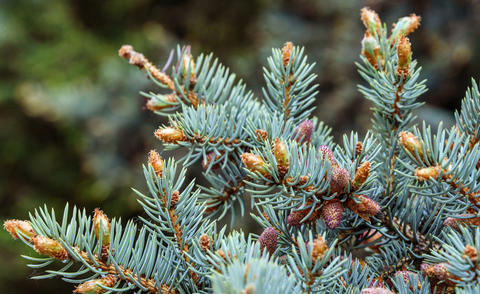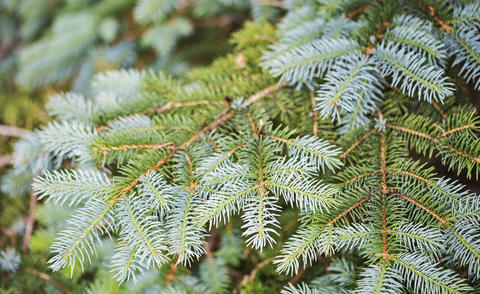Spruce, Blue Spruce
The Spruce, also known as the Blue Spruce thanks to its blue needles, is a great decorative element for the garden and a popular Christmas tree.
Factsheet
- Growth type
-
- Conifer
- Tree
- Growth height (from)
- from 1500 cm to 3500 cm
- Growth width (from)
- from 600 cm to 800 cm
- Growth characteristics
-
- conical
- upright
- Flower shape
-
- Cones
- Leaf color
-
- blue green
- page format
-
- needle-shaped
- Sheet properties
-
- evergreen
- Fruit color
-
- brown
- Fruit shape
-
- Cone
- Light
-
- sunny
- Soil type
-
- gravelly to loamy
- Soil Moisture
-
- moderately dry to fresh
- ph value
-
- alkaline to acidic
- Lime compatibility
-
- lime-tolerant
- Nutrient requirements
-
- nutrient-rich
- Humus
-
- rich in humus
- Decorative or utility value
-
- Fruit ornaments
- picturesque growth
- Winter Hardness
-
- hardy
- Climate zones according to USDA
-
- 4
- Use
-
- Single position
- Landscape woody plants
- Street greening
- Windbreak
- Garden style
-
- Park area
- Forest Garden
- Cemetery
The Blue Spruce (Picea pungens) is one of the best-known representatives of the genus of the Spruce (Picea). It is native to the Rocky Mountains, where it rises to an altitude of 9842.52 feet, and is a member of the pine family (Pinaceae). The Spruce is now widespread in Central Europe and Russia.
Picea pungens has a steady growth with a beautiful, conical crown. It reaches sizes between 5.90 and 13.77 feet. The older the spruce, the more picturesquely hang its branches from the center. The conifer is hardy up to minus 40 degrees Fahrenheit.
The needles of the Spruce are their namesake: They are extremely pointed and sharp at the upper end (apex). The needles, which are about 1.18 inches long, are square in cross-section. The needles shimmer in a yellow-green to blue-green shade. Many cultivars highlight the bluish wax coating on the needles, which is why the spruce is often called the Blue Spruce.

Spruce trees are monoecious, but with separate sexes (monodic). It takes about thirty years before the first bloom. Like all conifers, the Spruce also forms cones that grow around the crown. The male cones are yellow and reddish in color. The female, on the other hand, appear in a very light shade of red or pale green.
The 2.36 to 4.33 inches long, hanging seed cones later develop from the female flowers. These are initially reddish-green and turn light brown in color when the seeds are ripe in late summer. They contain the winged Spruce seeds, which are about 0.15 inches in size.
The Spruce feels most comfortable in the sun, it does not tolerate places in the shade well. Picea pungens sheds its needles in partially shaded locations. The Blue Spruce copes better with dry soils than other species of spruce. Although Picea pungens, like all spruces, is a shallow root plant, it is still wind resistant.

The Spruce is not demanding when it comes to the soil, it should only be permeable. The perfect soil for Picea pungens is sandy-gravelly loamy soil, which is rich in nutrients with an alkaline pH value.
You can plant a Spruce all year round. Container plants are usually planted in fall. The planting hole does not have to be deep but wide so that all roots can be spread out without kinks. Tip: Wear gloves and possibly protective goggles when planting, as the needles can cause unsightly injuries.
The Spruce is extremely easy to care for and does not require any special treatment.
Picea pungens is climate-proof and resistant to emissions, which is why it is a popular park and city tree. Its beautiful color and strong scent makes the spruce an ideal a Christmas tree, although the pointed needles require gloves while putting up decorations. In the garden, the Spruce is suitable as a solitary tree or as a windbreak wood. Smaller specimens can also be planted in the container.
Thanks to their beautiful needle color, the blue variants of the spruce are particularly welcome guests in the garden. One of the most famous garden forms is the titletitleBlue Spruce ‘Koster’, which has a particularly striking silver-blue needle cover. In addition to the ‘Koster’ and ‘Glauca varieties, ‘Hoopsii’ has the most intense blue color. After budding in mid-May, they appear their best. The ‘Glauca Globosa’ variety is a great addition to small gardens. It reaches a maximum height of 9.84 feet, initially growing spherical and later conical. The columnar variety ‘Iseli Fastigata’ is suitable for gardens with less space.

Propagation of the blue spruce works best with cuttings, more precisely over the cut edge. In the spring, tear off unwooded annual shoot tips from the mother plant, remove the lower shoots and place the cut edge together with the bark tongue in potting soil. Keep the cuttings moist and roots will slowly form over the summer. After overwintering in the house, the young plants can be kept outside in the next spring. Sowing is also possible, but it is a very tedious process.
Some fungi in particular can attack the spruce, including Chrysomyxa, which causes witches’ broom, and others, which lead to leaf shedding. Honey fungus and red ring rot occur occasionally. The Spruce aphid (Elatobium abietinum) should be mentioned as a pest, which can defoliate a tree completely if it is infected several times.

